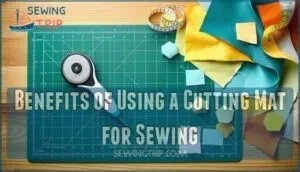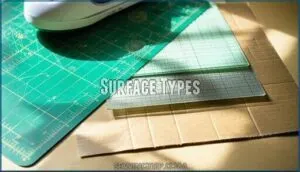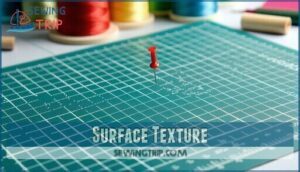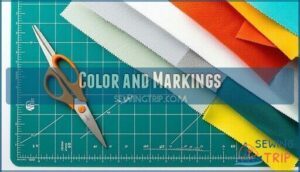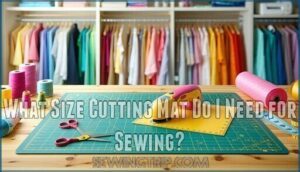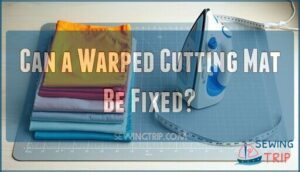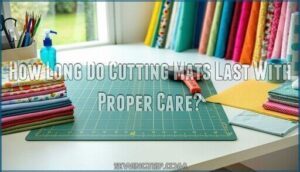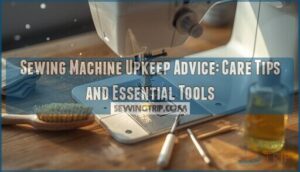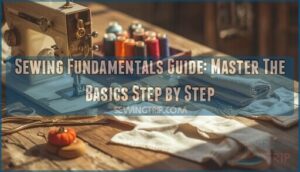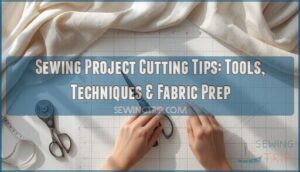This site is supported by our readers. We may earn a commission, at no cost to you, if you purchase through links.
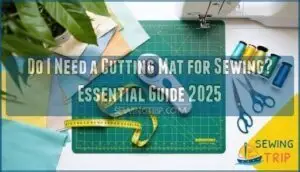
While you can technically cut fabric on any surface, a proper cutting mat protects your table from rotary cutter damage and provides grid lines for precise measurements.
These self-healing mats close up after each cut, maintaining a smooth surface that won’t dull your blades.
They grip fabric just enough to prevent slipping while you cut, which means straighter lines and less frustration.
Think of it as your sewing safety net—once you start using one, cutting fabric on anything else feels like trying to write with a broken pencil.
The right size and features can transform your entire cutting experience.
Table Of Contents
- Key Takeaways
- What is a Cutting Mat?
- Benefits of Using a Cutting Mat for Sewing
- Choosing The Right Cutting Mat for Your Sewing Projects
- How Does a Self-Healing Cutting Mat Work?
- What Size Cutting Mat Do I Need for Sewing?
- Can a Warped Cutting Mat Be Fixed?
- Where to Buy Cutting Mats?
- How Long Do Cutting Mats Last With Proper Care?
- Top Cutting Mats for Sewing Projects
- Frequently Asked Questions (FAQs)
- Conclusion
Key Takeaways
- You’ll protect your work surfaces from permanent damage while extending your rotary cutter blade life significantly when you use a cutting mat instead of cutting directly on tables or other surfaces.
- You’ll achieve precise, professional cuts with the grid lines and measurements that prevent fabric slippage and ensure accurate seam allowances every time you work on sewing projects.
- You’ll save money long-term since self-healing cutting mats automatically close small cuts and maintain their smooth surface for 6-10 years with proper care and maintenance.
- You’ll need to choose the right size for your workspace, with 18×24 inches being ideal for most sewing projects and 24×36 inches or larger for quilting and full-width fabric cutting.
What is a Cutting Mat?
A cutting mat serves as your fabric’s best friend—a specialized cutting surface designed specifically for sewing projects.
This self-healing mat features a durable composition that closes minor cuts automatically, extending its lifespan substantially.
Your cutting mat heals itself—literally closing cuts to stay smooth and functional for years of precision sewing.
Most sewing cutting mats use PVC or vinyl materials in their manufacturing process, creating a surface that’s both forgiving and precise.
Your fabric cutting mat displays grid lines, angle markings, and measurements that transform chaotic cutting into organized precision.
These types of grids help you align patterns, measure seam allowances, and create perfectly straight cuts every time.
The cutting surface sewing enthusiasts prefer typically measures between 12×18 inches to 24×36 inches, accommodating various project sizes.
When paired with a rotary cutter mat system, you’ll slice through multiple fabric layers effortlessly.
The mat’s material grades guarantee your rotary blade stays sharp longer while protecting your work surface underneath.
It’s basically your cutting foundation.
Benefits of Using a Cutting Mat for Sewing
A cutting mat transforms your sewing experience by protecting your work surfaces from sharp blades while providing the stability and precision measurements you need for accurate fabric cutting.
You’ll find that this essential tool saves your furniture and extends your blade life, and also makes every cut cleaner and more consistent, turning potentially frustrating cutting sessions into smooth, efficient parts of your sewing process, which is a key factor in having a smooth and efficient sewing experience.
Protection of Surfaces and Tools
Your workspace takes a beating without proper surface protection.
A sewing cutting mat acts as your table’s bodyguard, absorbing rotary cutter slashes that would otherwise leave permanent scars.
The mat composition features self-healing properties that close after each cut, ensuring damage prevention for both your furniture and blades.
This surface longevity investment pays dividends through blade preservation and tool sharpness maintenance.
Your fabric cutting mat transforms destructive cutting forces into manageable wear, protecting your rotary cutter mat investment, which is a result of its ability to provide surface protection and ensure damage prevention.
Improved Accuracy and Precision
Beyond protecting your workspace, cutting mats deliver remarkable precision that transforms your sewing results.
Grid lines act as your personal measurement guide, ensuring consistent seam allowance and accurate pattern cutting every time.
You’ll achieve precise fabric alignment without guesswork, creating sharp corners and mitering edges perfectly.
The stable surface prevents fabric from shifting during cuts, while angle markings help you maintain straight lines, which leads to professionally finished projects, eliminating the frustration of mismatched pieces, making your projects look professionally finished from start to finish.
Prolonged Blade Life
Your rotary cutter’s blade stays sharper longer when you use a cutting mat beneath your fabric.
The self-healing surface cushions each cut, reducing friction that dulls blades prematurely.
- Blade Material preservation through reduced metal-on-hard-surface contact
- Mat Hardness provides ideal resistance for clean cutting technique
- Self Healing Mat closes micro-cuts, maintaining smooth surface integrity
- Tool Longevity increases dramatically with proper blade maintenance practices
Smart cutting technique protects your investment.
Choosing The Right Cutting Mat for Your Sewing Projects
When you’re ready to invest in a cutting mat, you’ll need to examine several key factors that match your specific sewing needs and workspace requirements.
The right mat depends on your project types, available space, preferred measurements, and budget, with options ranging from basic self-healing surfaces to specialized rotating designs.
Surface Types
When choosing materials, self-healing mats offer the best protection for fabric projects, automatically closing small cuts from rotary blades.
Hard mats work well with scissors but lack this recovery feature. Glass surfaces provide ultra-smooth cutting but can dull blades faster.
Cardboard alternatives serve as budget-friendly options for occasional use. Portable stations combine cutting and pressing surfaces.
Your work surface choice directly impacts cutting precision and tool longevity. These mats utilize self-healing layer technology to achieve this protection.
Surface Texture
Your cutting mat’s surface texture directly affects how well your fabric stays put during cuts.
A slightly textured finish prevents fabric slippage while maintaining smoothness importance for clean cuts.
Too much grip variation creates drag, while overly smooth surfaces lack stable surface control.
Using a cutting mat with a ruler grid helps with accurate measurements.
This texture cleaning consideration impacts your cutting surface protection, ensuring your selfhealing material performs ideally on any work surface, with the right amount of grip.
Size
Finding the perfect cutting mat size starts with measuring your workspace needs carefully. You’ll want the largest mat that fits comfortably on your sewing table without hanging over edges.
A cramped cutting area makes precision work nearly impossible, while oversized mats become storage nightmares.
Consider these essential size factors:
- Small cutting mat (12"x18" to 18"x24") – perfect for quilting blocks and travel projects
- Large cutting mat (24"x36" to 36"x60") – handles full fabric widths and garment pieces
- Project dimensions – match mat size to your typical sewing projects
- Storage constraints – make certain you can store the mat flat when not in use
- Portability factor – smaller mats work better for classes or workshops
Standard measurements include 12"x18", 24"x36", and 36"x48" sizes. Different retailers offer various product options.
Remember, a larger cutting mat lets you cut bigger pattern pieces in one smooth pass, saving time and improving accuracy.
Color and Markings
Your cutting mat’s color affects visibility when cutting different fabrics.
Choose colors that contrast with your materials – dark mats highlight light fabrics, while lighter surfaces show dark materials clearly.
Many sewers explore various mat options for best contrast.
Grid lines and measurements should be easy to read against your chosen color, and look for angle markings at 45 and 60 degrees for accurate bias cuts and triangular pieces.
How Does a Self-Healing Cutting Mat Work?
Behind every perfect cut lies a cutting mat engineered with multiple layers cutting technology that works like magic. Your self-healing mat contains several distinct layers – a soft vinyl top surface, resilient middle layers made from PVC or thermoplastic elastomers, and a stable base that prevents warping.
A cutting mat is your fabric’s silent guardian—protecting surfaces while delivering the precision every sewist craves.
When your rotary cutter slices through the material composition, the blade separates tiny particles rather than creating permanent damage. The healing process happens instantly as the flexible material expands and contracts, pushing cut edges back together. This layer construction maintains durability factors remain strong even after thousands of cuts.
Here’s what makes self-healing properties so remarkable:
- Your blade stays razor-sharp longer because it’s cutting through forgiving material
- The surface maintains its smooth texture, preventing fabric snags
- Years of heavy use won’t leave visible scars or grooves
- Professional results every single time you cut
Sharp blade sharpness is vital – dull blades can’t make clean cuts that heal properly. With proper maintenance impact considerations, your self-healing mat will serve you faithfully for years.
What Size Cutting Mat Do I Need for Sewing?
Your workspace size dictates your cutting mat dimensions more than you might think.
Start with measuring your available table space, then consider your typical project scale.
For general sewing, an 18"x24" mat handles most garment pieces comfortably.
Quilting enthusiasts need larger mats—24"x36" or bigger—to accommodate multiple fabric strips simultaneously.
Fabric width matters too.
Standard 45-inch fabric folded becomes 22.5 inches wide, so your mat should exceed this measurement for efficient cutting technique.
Consider storage needs before buying that massive 36"x60" mat.
Smaller mats like 12"x18" work for detail work and travel classes.
Remember, you can always upgrade as your sewing skills and projects grow in complexity.
This allows for efficient use of space and resources, and enables you to work on more complex projects.
Can a Warped Cutting Mat Be Fixed?
Good news – you can rescue most warped cutting mats with simple heat treatment. Here’s how to bring your mat back to life:
- Lay the mat completely flat on a heat-resistant surface
- Set your clothes iron to medium heat without steam
- Iron over the warped areas using gentle, even pressure
- Allow the mat to cool while weighted down with books
- Check for complete flattening before storing properly
Warp Causes include improper storage and temperature changes. Repair Methods work best on self-healing vinyl mats, while rigid mats resist reshaping.
For ideal performance, consider a mat with double-sided features. Prevention Tips include flat storage and avoiding direct sunlight. Professional repair isn’t necessary – these Storage Solutions prevent future warping effectively.
Where to Buy Cutting Mats?
Shopping for a cutting mat doesn’t require a treasure hunt. You’ve got plenty of options right at your fingertips.
Local craft stores like Michaels and Joann’s stock various sizes and brands, letting you feel the mat’s texture before buying. Big box stores including Walmart and Target carry basic models in their craft sections.
For serious sewers, dedicated sewing shops offer premium options with expert advice. Don’t overlook craft fairs where vendors sometimes sell unique or discounted mats.
Online retailers shine when you need specific sizes or brands. Amazon’s vast selection includes user reviews that help narrow your choices. Before clicking "buy," do some price comparison shopping. The same mat might cost substantially less at different retailers.
Many sewers prefer mats that offer self-healing properties for increased longevity.
Whether you choose local stores for hands-on shopping or online retailers for convenience, you’ll find the perfect cutting mat for your sewing projects without breaking the bank.
How Long Do Cutting Mats Last With Proper Care?
Once you’ve found the perfect cutting mat, you’ll want to maximize its lifespan. With proper care, quality cutting mats can serve you faithfully for 6-10 years or even longer, making them a worthwhile investment for your sewing projects.
The key to cutting mat durability lies in consistent maintenance and mindful usage. Material quality plays a significant role, but your care routine determines longevity. Self-healing properties work best when you follow these essential practices:
- Rotation Practices: Change cutting directions regularly – make cuts vertically, horizontally, and diagonally to distribute wear evenly across the surface
- Blade Sharpness: Always use sharp rotary cutter blades and replace them frequently, as dull blades require excessive pressure and damage the mat
- Storage Methods: Store your mat completely flat in a cool, dry location to prevent warping and cracking
- Cleaning Frequency: Wipe down with mild soap and water after each use, avoiding harsh chemicals that degrade the material
- Smart Usage: Avoid cutting thick or sticky materials like leather or vinyl that can permanently damage the surface
Top Cutting Mats for Sewing Projects
Finding the right cutting mat transforms your sewing experience from frustrating fabric slippage to precise, professional results that make every project easier.
You’ll discover three top-rated cutting mats that offer the perfect combination of durability, accuracy, and value to match your specific sewing needs and workspace requirements, with professional results.
Olfa Gridded Cutting Mat
The Olfa Gridded Cutting Mat delivers exceptional Grid Accuracy with precise measurements and angle markings.
Its self-healing properties guarantee long-lasting Olfa Durability, while the preferred Mat Thickness provides stability without excessive weight. Perfect Blade Compatibility with rotary cutters extends blade life through reduced friction.
You can explore different Olfa cutting mat options to find the perfect fit for your needs.
| Feature | Specification | Benefit |
|---|---|---|
| Surface | Double-sided grid/solid | Versatile cutting options |
| Material | Self-healing vinyl | Extended mat lifespan |
| Sizes | Multiple options available | Workspace compatibility |
This cutting mat’s Preferred Usage shines in quilting and precision fabric work, where grid lines guide accurate cuts every time.
Prym Pink Cutting Mat
The Prym Pink Cutting Mat stands out with its vibrant pink aesthetics that cleverly mask cut marks and fabric stains.
This cutting mat delivers exceptional value proposition through its self-healing properties and anti-slip coating for sewing and quilting projects.
- Prym durability guarantees long-lasting performance with proper care
- Dual measurements feature centimeters and inches on opposite sides
- Color fading resistance maintains the mat’s bright appearance
- Alternative uses extend beyond fabric to paper crafting projects
Sew Easy Rotary Cutting Mat
The Sew Easy rotary cutting mat brings reliable performance to your sewing room with its self-healing surface that bounces back from countless cuts.
This mat features clear grid lines for accurate measurements and a non-slip base that keeps your fabric steady during cutting sessions.
A key feature is the mat’s three-layer construction which enhances its durability.
| Feature | Specification |
|---|---|
| Mat Thickness | Medium density for durability |
| Grid Visibility | High-contrast imperial/metric markings |
| Self-Healing Quality | Recovers from rotary cutter cuts |
| Rotary Cutter Compatibility | Works with all standard blade sizes |
| Portability Options | Lightweight design for easy transport |
Perfect for quilting and general fabric cutting projects, this mat delivers consistent results whether you’re working with delicate silks or sturdy denim.
Frequently Asked Questions (FAQs)
Do you need a cutting mat for a rotary cutter?
Yes, you’ll need a cutting mat for your rotary cutter.
It protects your work surface, keeps blades sharp longer, and provides essential grid lines for precise cuts.
Without one, you’ll damage tables and dull blades quickly.
Why do you need a cutting mat?
Like a shield protecting your knight’s armor, cutting mats safeguard your work surfaces from sharp rotary cutters.
While providing precise grid lines for accurate cuts, extending blade life, and preventing fabric slippage during cutting.
Do cutting mats really help cut fabric?
Cutting mats protect surfaces, keep fabric steady, and provide grid lines for precise measurements.
They’ll save your blades from dulling quickly and make your cuts cleaner and more accurate every time.
Which cutting mat should I use?
Ironically, the "perfect" cutting mat doesn’t exist—you’ll choose based on your workspace size, budget, and projects. Look for self-healing surfaces with clear grid lines, measuring 18×24 inches for versatility.
How do cutting mats work?
Cutting mats provide a protective, self-healing surface that cushions your rotary cutter while preserving blade sharpness.
You’ll place fabric on the gridded surface, align with measurements, then cut using steady pressure for precise results.
What size cutting mat do I Need?
Your workspace determines your mat size.
If you’ve got a small table, choose 18×24 inches. Larger cutting areas can handle 24×36 inches comfortably.
Don’t go bigger than your space allows—you’ll just create storage headaches.
Is a cutting mat necessary for sewing?
Like a trusty sidekick, cutting mats aren’t absolutely essential but they’re incredibly helpful.
You can sew without one using scissors, but mats protect surfaces, improve accuracy, and make rotary cutting safer and more precise. Improve accuracy, and make rotary cutting safer and more precise.
What can I use instead of a cutting mat for sewing?
You can substitute thick cardboard, wooden cutting boards, laminate sheets, or smooth hard surfaces.
These alternatives protect your table while providing stability for accurate cuts with rotary cutters or scissors, and glass desktops work well too.
Do I need a mat cutter?
Sharp tools deserve sharp decisions.
You don’t need a separate mat cutter—your rotary cutter handles fabric beautifully on cutting mats.
Mat cutters are specialized tools for cardboard and mounting materials, not fabric work, which is why they are not necessary for fabric cutting.
What is the purpose of the cutting mat?
Cutting mats protect your work surfaces from sharp tools while providing precise grid lines for accurate measurements.
They prevent fabric slippage, extend blade life, and create a stable foundation for clean, professional cuts, which helps in providing accurate measurements.
Conclusion
Picture Sarah, a beginner quilter who ruined her dining table with rotary cutter gouges before discovering cutting mats.
Don’t make her mistake. When asking "do I need a cutting mat for sewing," the answer is absolutely yes.
You’ll protect your surfaces, achieve precise cuts, and extend your blade life substantially.
Whether you choose a basic grid mat or premium self-healing option, this essential tool transforms chaotic cutting sessions into organized, accurate work.
Your sewing projects deserve this foundation.
- https://ecopecoart.com/blogs/news/cutting-mat-all-you-need-to-know-about-self-healing-cutting-mats
- https://www.youtube.com/watch?v=cYxKNiZ8yU4
- https://www.gathered.how/sewing-and-quilting/sewing/best-cutting-mat-for-sewing
- https://www.nationalsewingcircle.com/post/sewing-must-haves-all-about-cutting-mats
- https://stitchinheaven.com/blogs/howdy/quilting-and-sewing-cutting-mats-the-breakdown

